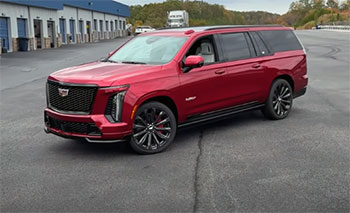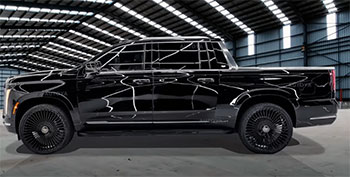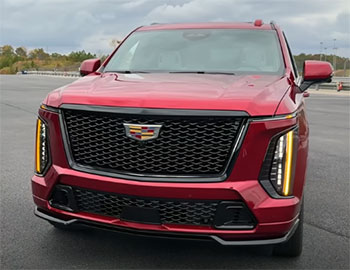I’ve always been drawn to the bold, commanding presence of Cadillac’s luxury SUVs and trucks, and the Escalade lineup is no exception. In this article, I’ll share my firsthand insights comparing the Cadillac Escalade ESV and the Cadillac Escalade EXT, two distinct vehicles that cater to different needs within the luxury segment.
My goal is to break down their key features, performance, and practicality, weighing the pros and cons to help you decide which model suits your lifestyle. Whether you’re after space, versatility, or unique style, this comparison will guide you toward the right choice.
Comparison Table: Escalade ESV vs. Escalade EXT
| Feature | Cadillac Escalade ESV (2025) | Cadillac Escalade EXT (2007-2013) |
|---|---|---|
| Body Style | Extended-length SUV | Luxury pickup truck |
| Length | 227 inches | 222 inches |
| Wheelbase | 134.1 inches | 130 inches |
| Seating Capacity | Up to 8 passengers | Up to 5 passengers |
| Cargo Space | 142.8 cu. ft. (max) | 45.5 cu. ft. (bed, Midgate up) |
| Engine | 6.2L V8 (420 hp) or 3.0L Turbo-Diesel (277 hp) | 6.2L V8 (403 hp) |
| Towing Capacity | Up to 8,000 lbs (RWD) | Up to 7,600 lbs |
| Fuel Economy (City/Hwy) | 14/19 mpg (V8, RWD) | 13/18 mpg (AWD) |
| Production Years | 2002–Present | 2002–2013 |
| Base Price (2024/Last) | $103,810 | ~$63,060 (2013 MSRP) |
| Drive Options | RWD or AWD | AWD only |
| Key Features | 55-inch OLED display, Super Cruise, 36-speaker AKG | Midgate system, navigation, rear-seat entertainment |
My Experience With the Cadillac Escalade ESV
When I first slid into the driver’s seat of the 2025 Cadillac Escalade ESV, I was struck by its sheer size and presence. This isn’t just an SUV—it’s a rolling statement of luxury and capability. The ESV, which stands for “Escalade Stretch Vehicle,” is the longer version of the standard Escalade, designed for those who need extra space without sacrificing Cadillac’s signature opulence.
Driving it through city streets and open highways, I felt like I was commanding a luxury liner. Its 227-inch length and 134.1-inch wheelbase make it a beast, but one that glides with surprising grace.

The interior is where the ESV truly shines. The cabin feels like a high-end lounge, with soft semi-aniline leather, heated and ventilated seats, and a massive 55-inch curved OLED display spanning the dashboard.
I could adjust the 16-way power seats to perfection, and the massage function was a godsend on long drives.
The third-row seating is genuinely usable, with 36.75 inches of legroom—nearly 2 inches more than the standard Escalade—making it ideal for adults or growing teens. Behind the third row, there’s 41.5 cubic feet of cargo space, expanding to 142.8 cubic feet with the seats folded.
I loaded up camping gear, groceries, and even a stroller without breaking a sweat.
Performance-wise, the ESV’s standard 6.2L V8 engine, pumping out 420 horsepower, delivers smooth, confident power. I tested the rear-wheel-drive version, which tows up to 8,000 pounds, perfect for hauling a boat or trailer. The optional 3.0L turbo-diesel, with 277 horsepower, offers better fuel economy but feels less punchy.
The 10-speed automatic transmission shifts seamlessly, and the available Air Ride Adaptive Suspension smooths out bumps, making highway cruising a dream. However, its 14/19 mpg (city/highway) isn’t winning any efficiency awards, and parking this 5,993-pound giant in tight urban spaces requires patience.
The ESV’s tech is cutting-edge. Super Cruise, Cadillac’s hands-free driving system, made highway trips effortless, while the 36-speaker AKG audio system turned every song into a concert. Safety features like lane-keeping assist, adaptive cruise control, and a 360-degree camera system gave me confidence in crowded areas. The rear-seat entertainment system, with larger screens and better angles, kept passengers entertained on long trips. For families or those who prioritize space and luxury, the ESV feels like the ultimate road-trip companion.
My Experience With the Cadillac Escalade EXT
The Cadillac Escalade EXT, discontinued in 2013, is a different beast altogether—a luxury pickup truck that blends SUV comfort with truck utility. When I had the chance to drive a 2013 model, I was intrigued by its unique design.
Based on the Chevy Avalanche, the EXT combines a 222-inch-long body with a 130-inch wheelbase and a versatile Midgate system that extends the cargo bed by folding down the rear seats. It’s not as long as the ESV, but it’s still imposing, with a bold chrome grille and sleek lines that scream Cadillac.

Inside, the EXT feels like a time capsule of early-2010s luxury. The cabin is decked out with leather and wood accents, but it lacks the modern polish of the ESV.
The 6.2L V8 engine, producing 403 horsepower, delivers strong acceleration—0 to 60 mph in about 7 seconds—but its 13/18 mpg fuel economy is even less impressive than the ESV’s. The all-wheel-drive system, standard on all EXTs, provides solid traction, but the 7,600-pound towing capacity is slightly lower than the ESV’s.
I found the ride firm but composed, though it doesn’t match the ESV’s refined Air Ride suspension.
The EXT’s standout feature is its versatility. The 5.3-foot cargo bed, expandable to 8 feet with the Midgate, let me haul everything from lumber to camping gear while keeping passengers comfortable in the cabin. The navigation system, Bluetooth, and rear-seat entertainment were advanced for their time, but they pale compared to the ESV’s 55-inch display and Super Cruise.
Safety features like blind-zone alerts and a backup camera were helpful, but the EXT misses out on modern driver-assistance tech. For those who need a luxury vehicle that can double as a workhorse, the EXT’s unique blend of style and utility is hard to beat, even if it feels dated today.
Read More: My Thoughts On Acura MDX Vs. Volvo XC90
Pros Of the Cadillac Escalade ESV
- Massive cargo and passenger space: With up to 142.8 cubic feet of cargo space and 36.75 inches of third-row legroom, the ESV is a champ for families or those hauling gear. I easily fit luggage, sports equipment, and groceries for a week-long trip without folding the third row.
- Luxurious interior: The cabin is a masterclass in comfort, with semi-aniline leather, 16-way power seats with massage, and a 36-speaker AKG audio system. Every drive felt like a first-class experience, especially with the heated steering wheel on chilly mornings.
- Cutting-edge technology: The 55-inch curved OLED display is stunning, and Super Cruise hands-free driving made long highway stretches effortless. The 360-degree camera and rear-seat entertainment kept everyone happy and safe.
- Powerful performance: The 6.2L V8’s 420 horsepower delivers smooth, confident acceleration, and the 10-speed automatic shifts flawlessly. Towing up to 8,000 pounds was no issue when I hooked up a trailer for a weekend getaway.
- Smooth ride quality: The Air Ride Adaptive Suspension absorbs road imperfections, making the ESV feel like a luxury sedan despite its size. Highway cruising was serene, even with a full load of passengers and cargo.
- Versatile seating configurations: With options for seven or eight passengers, the ESV adapts to different needs. The second-row bucket seats were a hit for comfort, and the third row was surprisingly spacious for adults.
The ESV’s strengths lie in its ability to combine luxury with practicality. Whether I was shuttling a group of friends or packing for a road trip, it never felt cramped. The tech, especially Super Cruise, made driving less stressful, and the premium materials elevated every journey. For anyone prioritizing space and modern features, the ESV is tough to top.
Cons Of the Cadillac Escalade ESV
- Poor fuel economy: The 6.2L V8’s 14/19 mpg (city/highway) is a gas guzzler, and my wallet felt the pinch on long trips. The diesel option improves efficiency but sacrifices some power.
- Cumbersome size: At 227 inches long, the ESV is a challenge to park in tight urban spaces. I had to circle multiple times to find spots big enough, and parallel parking was a workout.
- High price tag: Starting at $103,810, the ESV is a significant investment. Higher trims like the Premium Luxury Platinum push costs even further, which might not justify the extra space for some.
- Heavy curb weight: At nearly 6,000 pounds, the ESV feels sluggish in tight corners, and its weight impacts fuel efficiency and handling. I noticed it most when navigating winding roads.
- Third-row access: While spacious, getting to the third row requires some effort, especially with child seats installed. Folding the second row was easy, but climbing in wasn’t always graceful.
- Depreciation concerns: Luxury SUVs like the ESV tend to lose value quickly. Based on historical data, I’d expect a significant drop in resale value after a few years, which could sting for budget-conscious buyers.
The ESV’s size and cost are its biggest drawbacks. While the space is a boon, it makes city driving tricky, and the fuel economy forces frequent stops at the pump. For buyers who don’t need the extra length, the standard Escalade might be a smarter pick.
Pros Of the Cadillac Escalade EXT
- Unique pickup-SUV hybrid: The EXT’s Midgate system lets you extend the 5.3-foot bed to 8 feet, blending SUV comfort with truck utility. I loved hauling furniture while keeping passengers cozy.
- Bold Cadillac styling: The chrome grille and sleek design give the EXT a standout look. It turned heads everywhere I drove, combining luxury with a rugged edge.
- Strong performance: The 6.2L V8’s 403 horsepower delivers quick acceleration, hitting 0 to 60 mph in about 7 seconds. It felt peppy even with a loaded bed.
- Versatile cargo options: The expandable bed and lockable tonneau cover made it easy to transport everything from bikes to tools securely. I never worried about weather damage.
- Comfortable cabin: Despite its age, the leather seats, wood accents, and heated steering wheel offered a premium feel. The rear-seat entertainment system was a hit with passengers.
- All-wheel-drive confidence: Standard AWD provided excellent traction in rain and light snow, making the EXT reliable for varied conditions. I felt secure on slick roads.
The EXT’s ability to serve as both a luxury SUV and a capable pickup is its biggest strength. It’s perfect for those who want Cadillac’s flair with the practicality of a truck bed. Even years after its discontinuation, it remains a unique option in the luxury market.
Cons Of the Cadillac Escalade EXT
- Discontinued model: Production ended in 2013, so you’re limited to used vehicles. Finding a well-maintained EXT can be tough, and parts may be harder to source.
- Outdated technology: The navigation, Bluetooth, and infotainment feel dated compared to the ESV’s modern setup. The lack of Super Cruise or advanced safety features was noticeable.
- Lower towing capacity: At 7,600 pounds, the EXT lags behind the ESV’s 8,000-pound capacity. I felt the difference when towing heavier loads like a camper.
- Poor fuel economy: The 13/18 mpg (city/highway) is worse than the ESV’s, and the AWD-only setup doesn’t help. Gas costs added up quickly on long drives.
- Limited seating: With a maximum of five passengers, the EXT isn’t ideal for large families. I missed the ESV’s third row when traveling with a bigger group.
- Firm ride quality: The suspension, while capable, isn’t as refined as the ESV’s Air Ride system. Rough roads felt jarring, especially with a loaded bed.
The EXT’s age and limited availability are its biggest hurdles. The lack of modern tech and lower seating capacity make it less practical for families, and its fuel economy doesn’t help its case. Still, its unique design keeps it appealing for niche buyers.
Driving Dynamics and Handling

The Escalade ESV and EXT handle differently due to their designs and purposes.
The ESV, despite its 5,993-pound curb weight, feels surprisingly composed.
The Air Ride Adaptive Suspension adjusts to road conditions, smoothing out bumps and keeping the cabin serene. On highways, it glides like a luxury sedan, but in tight corners, its size and weight cause noticeable body roll. I took it through a winding mountain road, and while it held its own, it wasn’t as nimble as smaller SUVs.
The steering is precise but light, which suits its relaxed driving character. The optional magnetic ride control, which I tested on a Premium Luxury trim, sharpened handling without sacrificing comfort.
The EXT, built on a truck platform, has a firmer ride. Its suspension is tuned for payload and towing, so it feels stiffer, especially with a loaded bed. On smooth highways, it’s stable, but rough roads transmit more jolts to the cabin. I drove it over a gravel path, and the bumps were more pronounced than in the ESV.
The EXT’s steering is heavier, giving it a truck-like feel, which I appreciated when towing but found less forgiving in city traffic. Its all-wheel-drive system adds confidence in adverse conditions, but it doesn’t match the ESV’s refined handling.
Interior Comfort and Materials
The ESV’s interior is a modern masterpiece. The semi-aniline leather feels buttery, and the open-pore wood and metal accents elevate the cabin’s ambiance. Every touchpoint, from the knurled climate control knobs to the soft-close doors, screams quality.
The 16-way seats with massage were a highlight on a 10-hour drive, and the heated steering wheel was a lifesaver in cold weather. The third row, often an afterthought in SUVs, is genuinely usable, with enough headroom and legroom for my 6-foot friend to sit comfortably.
The EXT’s cabin, while luxurious for its time, shows its age. The leather and wood trim are high-quality, but the plastics around the center console feel dated compared to the ESV’s premium materials. The seats are comfortable but lack the ESV’s adjustability and cooling options.
The rear seats, limited to three passengers, are spacious but don’t match the ESV’s versatility. The EXT’s cabin is quieter than most trucks, but road noise is more noticeable than in the ESV, especially at highway speeds.
Technology and Connectivity
The ESV’s tech is a leap forward. The 55-inch OLED display integrates navigation, media, and vehicle info seamlessly, and its responsiveness rivals a high-end tablet. Apple CarPlay and Android Auto are wireless, and the Wi-Fi hotspot kept my passengers connected.
Super Cruise, available on higher trims, was a revelation, handling long highway stretches with minimal input. The augmented reality view, projecting directions onto the windshield, made navigation intuitive. The 36-speaker AKG system is overkill in the best way, delivering sound so clear I heard details in songs I’d missed before.
The EXT’s tech, while advanced for 2013, feels outdated. The touchscreen navigation is clunky, and the graphics are low-resolution compared to modern systems. Bluetooth worked well, but there’s no wireless CarPlay or Android Auto. The rear-seat entertainment, with a single roof-mounted screen, kept kids entertained but lacks the ESV’s dual-screen setup.
Safety tech is limited to basics like blind-zone alerts and a backup camera, missing the ESV’s comprehensive suite. For tech enthusiasts, the EXT’s systems are a stepongevity, the EXT’s cargo versatility and bold style are unmatched, though its age and limited availability pose challenges. Test both to find your perfect luxury ride.
Read More: My Thoughts On Acura MDX Vs. Jeep Grand Cherokee
Frequently Asked Questions (FAQ)
The Escalade ESV is a longer version of the standard Escalade, offering more cargo space (142.8 vs. 121.0 cu. ft.) and extra third-row legroom (36.75 vs. 34.9 inches). It’s ideal for those needing extra space but is pricier and harder to park.
ESV stands for “Escalade Stretch Vehicle,” indicating its extended wheelbase and length compared to the standard Escalade, providing more room for passengers and cargo.
The Escalade EXT was discontinued in 2013, ending its second generation, which ran from 2007 to 2013. It’s now only available on the used market.
The “best” depends on your needs. The ESV excels for families needing space and modern tech, while the EXT suits those wanting a luxury pickup with cargo versatility. Test-driving both helps decide.
Conclusion: For the Cadillac Escalade ESV and EXT
Choosing between the Cadillac Escalade ESV and EXT comes down to what you value most. If you need a spacious, modern luxury SUV with cutting-edge tech and room for eight, the ESV is your best bet. Its cavernous interior and features like Super Cruise make it perfect for families or long road trips, though its size and cost require commitment. If you’re drawn to a unique blend of luxury and truck utility, the EXT’s Midgate system and bold style are hard to beat, but its outdated tech and limited availability might give you pause. Test-drive both to see which fits your lifestyle—you won’t be disappointed either way.

